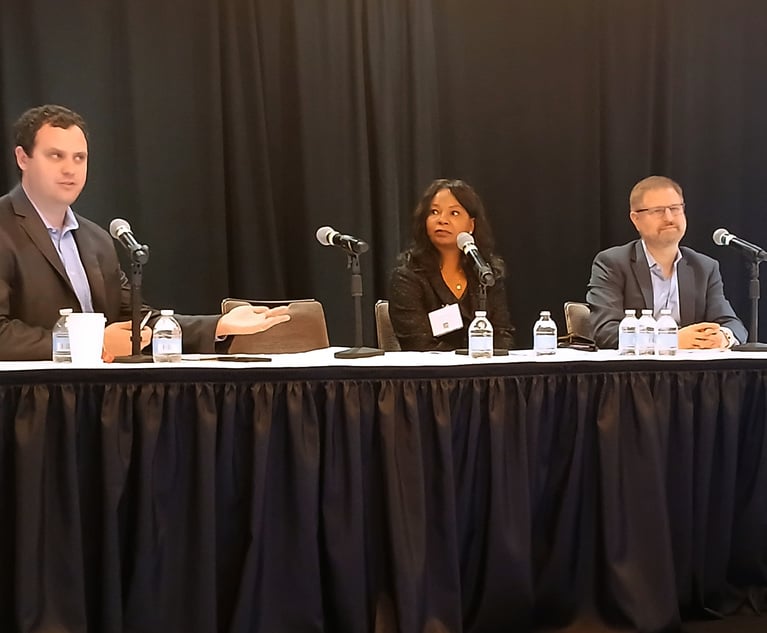Recession Realities
In-house counsel should be prepared to manage their legal departments through an economic downturn.
January 31, 2009 at 07:00 PM
4 minute read
Has “Get-up-and-brush-your-teeth” been replaced by “Get-up-and-refresh-the-browser”? Do you find yourself trapped in a Groundhog Day of market collapses, credit crises and impending layoffs? Are you asking yourself, “If fewer people buy what my company sells, what does that mean for my legal team?”
Until 2006, like most of those who started practicing in the 1990s or later, I'd generally only experienced a trend that was up and to the right.
In the semiconductor industry, however, crises are a regular occurrence. Industry recessions occur every few years as multiple customers race to be first to market. The fact that customers (and their financiers) have become a bit smarter about this over time is called “the rational allocation of capital.”
In learning the ropes, I benefited from the counsel of more experienced hands. Based upon that effort, below are some lessons learned:
Maintaining motivation is hard in small departments. Upward mobility is limited; lateral mobility more so. Lack of growth decreases mobility further.
Variable costs are better than fixed costs, and employees are fixed costs. The only thing more expensive than hiring a full-time employee is firing one.
In-house practice isn't easier–just (potentially) less lucrative. If you're reading this magazine, you know that “in-house is easier” is a myth. Accordingly, stalled growth and underwater options lead to itchy feet.
To deal with the above phenomena, we've seen the adoption of the following recommendations:
Hire fewer people; give them bigger jobs. Hire an IP lawyer and teach her to prepare the proxy. Find a way to build the bullets on their resumes that will get them their next job. To make sure the common questions continue to get answered, build wikis, make them available for outside counsel to edit and roll them out to internal personnel.
Pay them more. You've just given them bigger jobs, so be ready to pro forma the Radford data. If the finance or HR departments push back, tell them you're driving to increase revenue per person, and that you're focused on making legal costs vary with the business. Talk (on both sides) is cheap, though: You need to actively survey your internal clients, anonymously and otherwise, to make sure you and your people are walking the walk.
21st Century Management. Simply managing law firms alone doesn't count. They're well paid to take orders (while telling you how smart and good-looking you are). Instead, your employees should be actively sourcing, vetting and training outside vendors. That associate who left on paternity leave might be available to review non-disclosure agreements from home. Using your network to reaggregate disaggregated resources is a core 21st century skill.
Break the Hourly-Fee-For-Service Mold. Is this the year more clients move to the Fenwick & West Model? Is this the year law firms use Legal OnRamp to make their work product available to prospective clients? Is this the year law firms look at their projections and realize they need to find new ways to work with their clients?
Mutual Timetable. A wise man once told me good lawyers reinvent their practices every three to five years. He didn't mention an in-house counsel exception.
Accordingly, look to train one or more members of your team to do your job within that time frame. And while they're learning from you, you need to learn from others how to do something else.
Whether someone on your staff gets your job is not the point. Strive to put your personnel in a position to do a bigger job if and when that opportunity comes. If your company is growing again by then, you'll have well-trained colleagues. If not, you'll end up with either a successor or a grateful peer now paying forward the lessons you learned in this downturn.
This content has been archived. It is available through our partners, LexisNexis® and Bloomberg Law.
To view this content, please continue to their sites.
Not a Lexis Subscriber?
Subscribe Now
Not a Bloomberg Law Subscriber?
Subscribe Now
NOT FOR REPRINT
© 2024 ALM Global, LLC, All Rights Reserved. Request academic re-use from www.copyright.com. All other uses, submit a request to [email protected]. For more information visit Asset & Logo Licensing.
You Might Like
View All
GC Conference Takeaways: Picking AI Vendors 'a Bit of a Crap Shoot,' Beware of Internal Investigation 'Scope Creep'
8 minute read
Why ACLU's New Legal Director Says It's a 'Good Time to Take the Reins'

'Utterly Bewildering': GCs Struggle to Grasp Scattershot Nature of Law Firm Rate Hikes
Trending Stories
- 1Law Firm Associates, Staffers Continue to Put a Premium On Workplace Flexibility, Study Finds
- 22 Carter Arnett Litigators to Join Baker & Hostetler in Dallas
- 3People in the News—Nov. 27, 2024—Flaster Greenberg, Tucker Arensberg
- 4Cybersecurity Special Section 2024
- 5How I Made Office Managing Partner: 'Being Understanding, Fair and Impartial Are Key Requirements,' Says Gregory Noonan of Hogan Lovells
Who Got The Work
Michael G. Bongiorno, Andrew Scott Dulberg and Elizabeth E. Driscoll from Wilmer Cutler Pickering Hale and Dorr have stepped in to represent Symbotic Inc., an A.I.-enabled technology platform that focuses on increasing supply chain efficiency, and other defendants in a pending shareholder derivative lawsuit. The case, filed Oct. 2 in Massachusetts District Court by the Brown Law Firm on behalf of Stephen Austen, accuses certain officers and directors of misleading investors in regard to Symbotic's potential for margin growth by failing to disclose that the company was not equipped to timely deploy its systems or manage expenses through project delays. The case, assigned to U.S. District Judge Nathaniel M. Gorton, is 1:24-cv-12522, Austen v. Cohen et al.
Who Got The Work
Edmund Polubinski and Marie Killmond of Davis Polk & Wardwell have entered appearances for data platform software development company MongoDB and other defendants in a pending shareholder derivative lawsuit. The action, filed Oct. 7 in New York Southern District Court by the Brown Law Firm, accuses the company's directors and/or officers of falsely expressing confidence in the company’s restructuring of its sales incentive plan and downplaying the severity of decreases in its upfront commitments. The case is 1:24-cv-07594, Roy v. Ittycheria et al.
Who Got The Work
Amy O. Bruchs and Kurt F. Ellison of Michael Best & Friedrich have entered appearances for Epic Systems Corp. in a pending employment discrimination lawsuit. The suit was filed Sept. 7 in Wisconsin Western District Court by Levine Eisberner LLC and Siri & Glimstad on behalf of a project manager who claims that he was wrongfully terminated after applying for a religious exemption to the defendant's COVID-19 vaccine mandate. The case, assigned to U.S. Magistrate Judge Anita Marie Boor, is 3:24-cv-00630, Secker, Nathan v. Epic Systems Corporation.
Who Got The Work
David X. Sullivan, Thomas J. Finn and Gregory A. Hall from McCarter & English have entered appearances for Sunrun Installation Services in a pending civil rights lawsuit. The complaint was filed Sept. 4 in Connecticut District Court by attorney Robert M. Berke on behalf of former employee George Edward Steins, who was arrested and charged with employing an unregistered home improvement salesperson. The complaint alleges that had Sunrun informed the Connecticut Department of Consumer Protection that the plaintiff's employment had ended in 2017 and that he no longer held Sunrun's home improvement contractor license, he would not have been hit with charges, which were dismissed in May 2024. The case, assigned to U.S. District Judge Jeffrey A. Meyer, is 3:24-cv-01423, Steins v. Sunrun, Inc. et al.
Who Got The Work
Greenberg Traurig shareholder Joshua L. Raskin has entered an appearance for boohoo.com UK Ltd. in a pending patent infringement lawsuit. The suit, filed Sept. 3 in Texas Eastern District Court by Rozier Hardt McDonough on behalf of Alto Dynamics, asserts five patents related to an online shopping platform. The case, assigned to U.S. District Judge Rodney Gilstrap, is 2:24-cv-00719, Alto Dynamics, LLC v. boohoo.com UK Limited.
Featured Firms
Law Offices of Gary Martin Hays & Associates, P.C.
(470) 294-1674
Law Offices of Mark E. Salomone
(857) 444-6468
Smith & Hassler
(713) 739-1250







